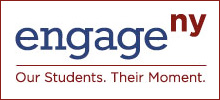8.2 - A Changing Society
From EngageNY
Industrialization and immigration contributed to the urbanization of America. Problems resulting from these changes sparked the Progressive movement and increased calls for reform.8.2a Technological developments changed the modes of production, and access to natural resources facilitated increased industrialization. The demand for labor in urban industrial areas resulted in increased migration from rural areas and a rapid increase in immigration to the United States. New York City became the nation’s largest city, and other cities in New York State also experienced growth at this time.
- Students will identify groups of people who moved into urban areas, and examine where they came from and the reasons for their migration into the cities. Students will explore the immigrant experience at Ellis Island.
- Students will compare and contrast immigrant experiences in locations such as ethnic neighborhoods in cities, rural settlements in the Midwest, Chinese communities in the Far West, and Mexican communities in the Southwest.
- Students will examine the population growth of New York City and other New York cities and the technologies and industries which encouraged this growth.
- Students will examine the living conditions in urban areas with a focus on increasing population density and the effects that this growth had on the social, cultural, and economic lives of people.
- Students will examine nativism and anti-immigration policies, including the Chinese Exclusion Act, the Gentlemen’s Agreement, and immigration legislation of the 1920s.
- Students will explore the growth and effects of child labor and sweatshops.
- Students will explore the development of political machines, including Boss Tweed and Tammany Hall.
- Students will examine the goals and tactics of specific labor unions including the Knights of Labor, the American Federation of Labor, and the Industrial Workers of the World.
- Students will examine key labor events including the Haymarket affair, the Pullman Strike and the International Ladies Garment Workers’ Union strike.
- Students will examine the Populist Party as a reform effort by farmers in response to industrialization.
- Students will investigate reformers and muckrakers such as Jane Addams, Florence Kelley, W. E. B. du Bois, Marcus Garvey, Ida Tarbell, Eugene V. Debs, Jacob Riis, Booker T. Washington, and Upton Sinclair. Student investigations should include the key issues in the individual’s work and the actions that individual took or recommended to address those issues.
- Students will explore leaders and activities of the temperance and woman’s suffrage movements.
- Students will investigate the Triangle Shirtwaist Fire and the legislative response.
- Students will examine state and federal government responses to reform efforts, including the passage of the 17th amendment, child labor and minimum wage laws, antitrust legislation, and food and drug regulations.
Learn more on Engage NY
EngageNY.org is developed and maintained by the New York State Education Department (NYSED) to support the implementation of key aspects of the New York State Board of Regents Reform Agenda.
This is the official web site for current materials and resources related to the Regents Reform Agenda. The agenda includes the implementation of the New York State P-12 Common Core Learning Standards (CCLS), Teacher and Leader Effectiveness (TLE), and Data-Driven Instruction (DDI). EngageNY.org is dedicated to providing educators across New York State with real-time, professional learning tools and resources to support educators in reaching the State’s vision for a college and career ready education for all students.














